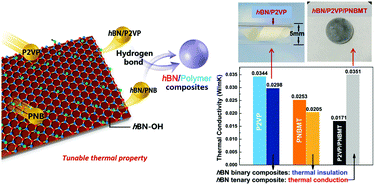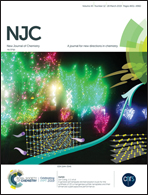Fabrication of boron nitride nanosheet/polymer composites with tunable thermal insulating properties†
Abstract
Hexagonal boron nitride (hBN) is usually used in thermal spreading applications because of its high thermal conductivities (400–2000 W mK−1). However, in composites with poly(2-vinylpyridine) (P2VP) and poly(5-norbornene-2-methanol) (PNBMT), the introduction of hydroxylated hBN enhances the thermal conductivity of the ternary formula but decreases it in the binary ones. This arises from the micro-interface defects and porous microstructure that form in the hBN/P2VP composite, which accounts for the thermal insulating property. In addition, the lightweight hBN/P2VP composite has good bendability and high thermal stability. The hBN/PNBMT composite possesses a wrinkled rough surface and voids, with hBN exposed or embedded in the polymer matrix, which disrupts the compact packing of polymer chains, thus increasing the extrinsic scattering and the free volume. In contrast, in the hBN/P2VP/PNBMT ternary composite, the synergistic interactions among the polymer chains and hBN result in a dense packing, lower surface area and higher density. This work provides a possible strategy to design hBN/polymer nanocomposites with tunable thermal properties.



 Please wait while we load your content...
Please wait while we load your content...